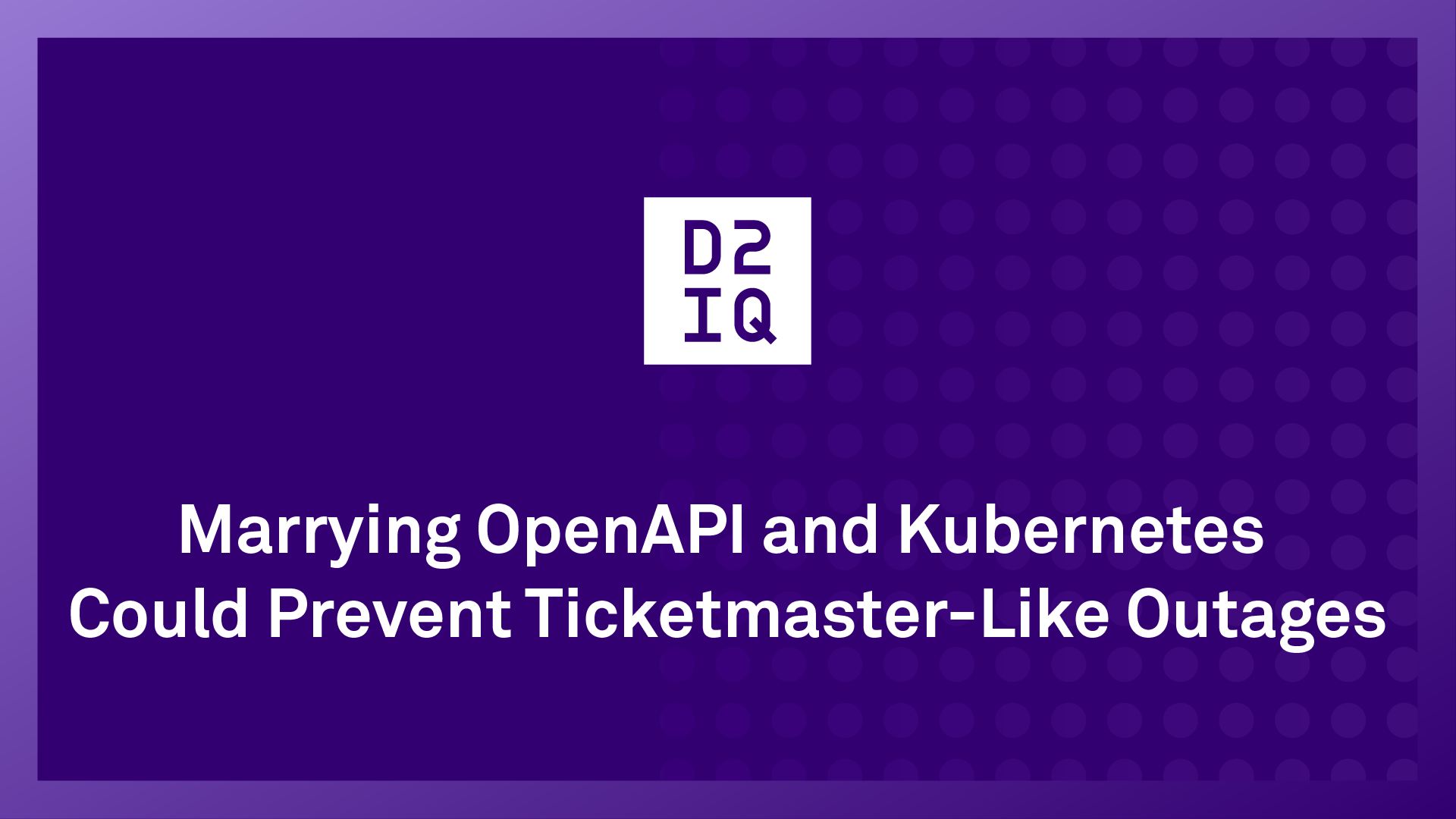OpenAPI & Kubernetes to Prevent Ticketmaster-Like Outages | D2iQ

5 min read
Like most Taylor Swift fans, I was disappointed in the Ticketmaster crash during the presale for her current tour. The preorder fiasco reminds me of bottlenecks that all enterprises and organizations encounter on their digital transformation journey while they strive to balance the delivery of stable products with rapid application development to drive innovation and meet evolving customer needs. At some point, their infrastructure will be calling out, “It’s me! Hey! I’m the problem! It’s me!”

@johnstocker via stock.adobe.com
I was at Google when we cofounded the OpenAPI Initiative and rallied support behind the OpenAPI Specification (OAS). I’ve watched how a series of open-source and open-spec projects like OAS have transformed the technology industry. If properly implemented, these projects can help companies avoid debacles like the one experienced by Ticketmaster.
As I’m witnessing the marriage between the openness and integration enabled by OAS and the efficiency and scalability empowered by Kubernetes, I see how this marriage can produce resilient and agile applications, enabling organizations to avoid the type of service crash we saw with Ticketmaster, and perhaps the recent FAA outage that grounded thousands of flights nationwide.
A lingua franca for Interoperation
The open standard and the language-agnostic interface offered by OAS can greatly improve the communication between developers and can remove the need to read source code or write new code and documentation when connecting to different systems. This enables developers to more efficiently access other platforms or enterprises’ APIs and quickly provide new services to their customers. The ticket ecosystem is one example in which the integrations made possible by APIs have enabled the industry to flourish, and consumers have more ability than ever to buy tickets (especially on the resale market!).
The advantages of a common specification have led to widespread acceptance and use by enterprises. According to openapis.org, there are thousands of API developers using OAS to document services worldwide, and enterprises are using OAS to share, collaborate, and provide services to other enterprises and customers. This has made OAS the lingua franca for interoperation among enterprises.
Although we think of the OpenAPI spec as the common language through which developers can speak to one another, there’s another benefit: OpenAPI is also how we speak to our API infrastructure. All modern API management infrastructure uses OAS to describe how an API will be managed. Standardizing the language we use to speak to our infrastructure is fantastic: The open, collaborative, and communicative nature of OAS makes it simpler and more efficient to manage and even replace infrastructure.
As we standardize how we speak to and configure our infrastructure, it gives enterprises the ability to choose the right solution for their problems. That means that if your old platform can’t scale the way you need it to today, it’s easier to change to a solution that’s scalable enough.
Kubernetes Scales All Businesses
The Ticketmaster presale fiasco also highlights the need for enterprises to be able to scale on the back end. Scalability is critical nowadays because digital transformation is causing higher volumes of traffic than enterprises have ever experienced, very similar to what we recently saw with Ticketmaster. Being able to scale quickly and efficiently can mean the difference between a sold-out tour and irate fans. Naturally, Kubernetes lets enterprises quickly deploy and manage cloud-native applications and, critically, scale them.
While enterprises are moving to cloud-native for a more scalable infrastructure and application deployments, Kubernetes’ wide adoption across the globe has made it the de facto choice in modern-day architectures for container orchestration management. According to our recent Enterprise Kubernetes report, three-quarters (75%) of enterprises are using Kubernetes for production (40%) and development or pre-production (35%).
Because it’s non-vendor-specific, Kubernetes has become the way we describe how a workload gets to a server, and its universality and portability mean it can be used on any cloud provider and in any data center. This means that companies like Ticketmaster can more easily than ever ensure that they are using a provider that can meet all of their scalability needs.
OpenAPI + Kubernetes Accelerates Business
Enterprises leverage Kubernetes to consistently and efficiently scale applications and services from the back-end cloud-native infrastructure, while OAS uses an open interface language to bring services to a broader market and customer base. The two, together, provide efficient and integrated management and operational advantages for enterprises, from infrastructure management in the back end to integration with other services, while providing convenience for customers in the front end.
There is yet another major advantage to adding both of these technologies to a modern cloud-native strategy: Scalability at once!
I mentioned that the connections OAS brings with other businesses and services lead to more market opportunities. As traffic through APIs grows rapidly, enterprises need to scale their API infrastructure and API gateways to ensure that the quality of service is not impacted. Here’s where Kubernetes can make a big difference. The inherent scalability of Kubernetes can keep enterprises agile and efficient in the face of massive traffic spikes, as its automatic scaling lets DevOps teams scale up or down to meet demand faster.
With this natural scalability advantage, when choosing to deploy API gateways with Kubernetes, enterprises can achieve the same level of scalability without all the fuss of figuring out another way to do it. In other words: the same technology that scales the back ends can scale the API infrastructure itself.
At Google, we took advantage of container-based API management infrastructure to run several of the most-used APIs on the planet (think Google Maps, Google Cloud, and the GSuite APIs). It was the combination of a standard way to describe those APIs to the world, a standard way to describe those APIs to the infrastructure, and a container-based horizontal scalability model that made it all happen.
Now Is the Right Time to Combine
Marc Andreessen said in 2011 that software was eating the world, and his prediction became a reality. In fact, Kubernetes and the OpenAPI Specification are playing a big role in enabling software to eat the world. OAS ensures that developer teams across companies and industries can communicate with one another. And Kubernetes has ushered in an era of horizontal scalability. Together, OAS and Kubernetes have standardized how we describe software services to the infrastructure on which they run, giving us the unprecedented ability to choose the right infrastructure providers to meet customer needs.
As more companies turn into software companies, the user experience will become the predictor of success in today’s digital era. Exposing your services as APIs with the OAS and managing spikes in demand with Kubernetes can help ensure that your users never notice a disruption because, after all, “the show must go on.”
To learn how D2iQ can help you create a resilient, scalable, and highly available Kubernetes infrastructure, speak with the experts at D2IQ.








